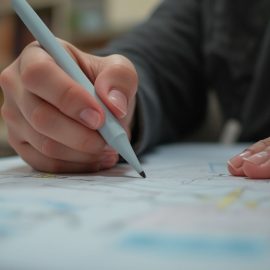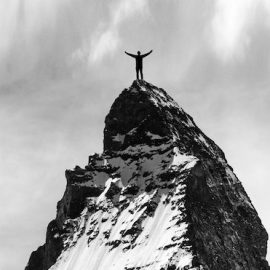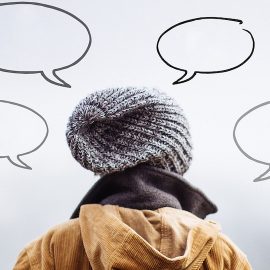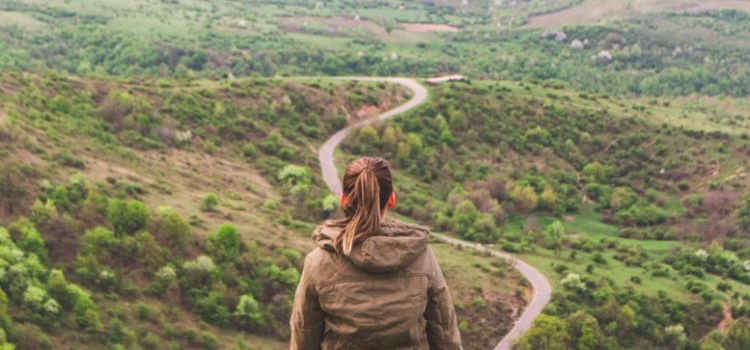
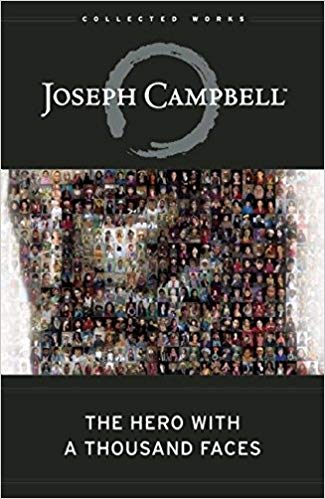
This article is an excerpt from the Shortform summary of "The Hero with a Thousand Faces" by Joseph Campbell. Shortform has the world's best summaries of books you should be reading.
Like this article? Sign up for a free trial here .
What is the hero’s journey? How is it relevant today?
The hero’s journey is a template of the plots of ancient and current myths and legends. It was popularized by Joseph Campbell in The Hero With a Thousand Faces.
We’ll cover what the hero’s journey entails and why it’s still relevant today.
What Is the Hero’s Journey?
The hero’s journey was made popular by Joseph Campbell. The Hero With a Thousand Faces is a journey through the world’s mythological traditions, from the ancient Egyptians, to the Romans, the Hindu and Buddhist legends of the east, and the folk-tales and foundation myths of the indigenous peoples of the Americas and Oceania.
It explores the common themes and story elements that define the world’s mythologies—though cultures are separated by vast gulfs of space and time, they all tell their stories in similar ways, using the same essential mythological template: the hero’s journey.
The Hero’s Journey
The archetypal myth is that of the hero’s journey, which details the exploits of an exalted figure such as a legendary warrior or king. But the hero can also start out as an obscure figure of humble origins, on the fringes of society. Frequently, this hero is born to lowly circumstances in a remote corner of the world and is the product of immaculate conception and virgin birth. Thus, they start out with some essential element of the gods already inside them.
The hero sets out on a journey to acquire some object or attain some sort of divine wisdom. This can be something material (like Arthur’s quest for the Holy Grail) or something with far greater spiritual weight (like the Buddha’s journey to find ultimate enlightenment). The hero undergoes great trials and tribulations during the course of their quest, undergoes a spiritual (and sometimes literal) death and rebirth, and transforms into an entirely new being. They gain new powers, and with those powers, achieve their goal—they receive the ultimate boon. They then return home to share this heavenly reward with their people—and in doing so, redeem all mankind.
What Is the Hero’s Journey? Stages:
- The call to adventure
- Refusal of the call
- Supernatural aid
- Crossing the threshold
- Belly of the whale
- The road of trials
- The meeting with the goddess
- Woman as temptress
- Atonement with the father
- Apotheosis
- The ultimate boon
- Refusal of the return
- The magic flight
- Rescue from without
- The crossing of the return threshold
- Master of two worlds
- Freedom to live
What is the hero’s journey? Although the hero’s journey is often filled with daring exploits, the slaying of fantastical monsters, and unions with strange and beautiful goddesses, it is at heart a deeply introspective and inward-looking adventure, one with profound spiritual and psychological implications. Through their arduous trial, the hero learns new things about himself or herself and discovers hidden strengths that were dormant within them the entire time—in fairy tales, this is often made literal by the revelation of the hero to have been “the Chosen One” or “the King’s son.” These new (but latent) powers enable a thorough transformation of the hero’s outward being and psyche.
When viewed this way, mythology is deeply egalitarian. It tells us who we are and the rewards that await us if we would only set aside our focus on the day-to-day humdrum of life and embrace the hero’s journey. The hero, far from being just a literary character of long-dead civilizations, symbolizes the great godly potential within all of us.
The Hero With a Thousand Faces breaks down this mythological template even further and also explores the creation and destruction stories that mankind has told since before the age of recorded history, from cultures all over the world. A few key themes emerge.
The Monomyth
What is the hero’s journey? Another name for it is the monomyth. The core structure of mythology is called the monomyth. It involves three rites of passage—separation, initiation, and return. From the myths of the ancient Egyptians and the medieval Arthurian legend to the folk-tales of the native Maoris of New Zealand, the pattern of the hero’s journey usually follows this cycle: a separation from the world he or she has always known (embarking on the quest), gaining some spiritual or other-worldly power, and a return in which they share the boon of the new power with humanity.
There are familiar beats throughout world-legend—the call to action; the initial reluctance of the hero; the aid of a supernatural helper; the crossing of the threshold into the world of the unknown; union with the mother-goddess; the slaying of the father-god; the return to the land of the living; and the sharing of the ultimate boon.
Creation and Destruction
What is the hero’s journey? The hero’s journey also points us to our place in the cosmos, our role in the great movement of the universe. Just as the monomyth shows the death, birth, and transformation of the individual in the form of the hero, so does mythology show the workings of all time and space—the origin story of the universe, and the means by which it will be destroyed and rebuilt. This is often represented as a universe without end, a universal round.
In a version of this cycle told among the Aztecs of pre-Columbian Mexico, each of the four elements—water, earth, air, and fire—in their turn marked the end of an age of the world:
- the age of water ended in a flood (flood-myths are a common feature of mythological tradition)
- the age of earth culminated in an earthquake
- the age of wind finished with destruction by wind, or hurricane
- and the (present) age of fire would be brought to an end by flames.
In the cosmogonic cycle of the Jains, eternity is represented as a spoked wheel, with each spoke representing one of the endlessly repeated ages of the universe, continuing in a permanent cycle.
Psychological Journey
What is the hero’s journey? Another way to answer this question is through its role in psychology. Myths are a society’s outward manifestations of inner conflicts and desires—they represent the expression of unconscious fears and desires. Here are common elements of myths that relate to psychological tensions or needs:
- The hero often first refuses the call to adventure. In psychoanalysis terms, this reflects the clinging to infantile needs for security. The mother and father are the figures preventing true growth and transformation.
- Once set off on an adventure, the hero encounters a point where they are further away from the world of comfort and familiarity than they have ever been before. This aspect of the heroic monomyth parallels the dangers and uncertainties of growing out of childhood and away from the protection of one’s parents.
- The hero often encounters goddesses, taking the form either of beauty and the feminine ideal, or of a witch who attempts to harm the hero. These figures represent the need to balance 1) our need for the love and protection of our parents (especially our mothers) with 2) our concurrent need to grow up and become independent adults.
- The hero also often encounters a father-god figure whom the hero must either overcome or reconcile with. In Freudian terms, this echoes the psychological rivalry that children feel toward their fathers. The father is the original intruder who enters the infant’s life after the serenity and union with the mother (goddess) in utero.
- After conquering their fears, the hero at last achieves their long-sought enlightenment. They have shattered the bounds of consciousness and reached a divine state. This teaches us that this power lives within us all—we achieve it through our own herohood.
In modern times, this need to express unconscious desires is filled by the psychoanalyst, who analyzes and interprets dreams (a pure expression of the unconscious) and gives them meaning and structure. This is, in fact, a deeply ancient and profoundly mythic function— the psychoanalyst, like the medicine man and bard of old, helps us gain a deeper understanding of ourselves, our world, and our relationship to the cosmos. When we open ourselves up on the therapist’s couch, we are going into the furthest corners of the mind—we are, in effect, undergoing our own hero’s journey.
Let’s discuss two examples of myths to illustrate the pattern and answer the question, What is the hero’s journey?
The Struggle of the Buddha
In the story of the Struggle of the Buddha, the founding story of Buddhism, we see all three elements of the monomyth. First, we see separation. The prince Gautama Sakyamuni (also known as Siddartha Gautama and the Future Buddha) escapes his ancestral home and cuts off his royal locks. He assumes the costume of a monk, wandering through the world and living a life of extreme austerity and asceticism. During this time, he transcends to the eight stages of meditation.
Next, we witness initiation. One day, he tosses an empty bowl into a river, and sees that the bowl flows upstream. This is the signal that his time of ultimate enlightenment is near at hand. He journeys to the Tree of Enlightenment, where he meets Kama-Mara, the god of love and death. Kama-Mara attempts to dislodge him from the tree, deploying all manner of fearsome monsters and deities at Gautama. But in repelling all of Mara’s onslaughts, the Future Buddha acquires knowledge of his previous existences, the power of omniscience, and a divine understanding of the chain of causation. He becomes Buddha, “The Enlightened One.”
Finally, we see return. After this victory, Buddha initially despairs of being able to communicate his message. But the god Brahma dissuades him from this pessimism and urges him to teach gods and men the path of enlightenment. Thus, Buddha returns to the cities and the hustle and bustle of the world from which he had originally come to share the gift of his knowledge and wisdom with the world.
The Legend of Moses
The cycle also shows itself in a story more familiar to Western audiences, that of Moses in the Old Testament. After the Exodus from Egypt, Moses leads the Israelites through the wilderness of Sinai (departure). Moses ascends Mount Sinai to receive the Tables of the Law from God, who commands Moses to share them with the Israelites, the chosen people (initiation).
When Moses returns to share the word of God with the people, God shakes the bounds of the world, unleashing fire, earthquake, storm, and hail. God appears from all directions, to demonstrate His all-knowing, all-seeing power. The crowd gathers to see the spectacle, but there is room for all—God is one with the people Israel (return).
The Function of Mythology Today
What is the hero’s journey today? Unlike the ancients, we do not have the benefit of allegory and mythology to help us make sense of the bubbling up of our subconscious. As a secular, rational society, we increasingly lack the language to process this—psychoanalysis may be the closest thing, but it is not a substitute for the power of mythology and religion. Indeed, we have rationalized and argued our gods away.
With the coming of secularization and rationalization, supernatural elements are often played down or meant to be interpreted simply as allegory or instructive fable. It is easy for this to happen to myths in modern, science-driven society, because it is easy to prove that the myths aren’t literally “true.” As history, biography, and science, mythology is obviously nonsense. But to make this observation is to miss the point about what myths are and what purpose they serve for the human experience. They are about the endless journey of the soul, the adventure into the furthest recesses of the self.
It is only through studying these ancient soothsayers and shamans and the dead gods they once worshipped that we can truly grasp our fullest humanity.
Mythology is still relevant. It binds us closer and provide us with a shared sense of community. Though we may lead atomized lives as husbands, wives, sons, daughters, professionals, and members of this or that nationality, we are bound together through shared myths. The ceremonies that derive from mythology, those of birth, initiation, marriage and death, remind us that we are part of something much larger than ourselves. We are only a cell, an organ of a much larger being. This is as true for us as it was for the ancients. Like Odysseus, like the Buddha, like Cuchulainn, great marvels and unfathomable transformations await the modern hero who heeds the mythic call.
———End of Preview———

Like what you just read? Read the rest of the world's best summary of "The Hero with a Thousand Faces" at Shortform . Learn the book's critical concepts in 20 minutes or less .
Here's what you'll find in our full The Hero with a Thousand Faces summary :
- How the Hero's Journey reappears hundreds of times in different cultures and ages
- How we attach our psychology to heroes, and how they help embolden us in our lives
- Why stories and mythology are so important, even in today's world

